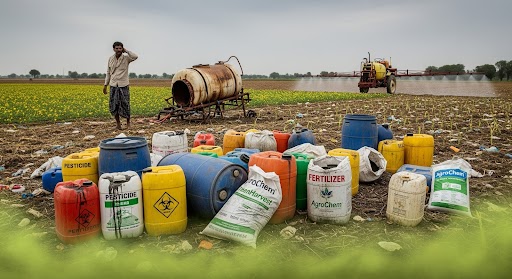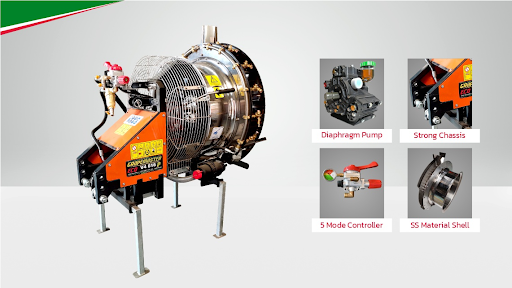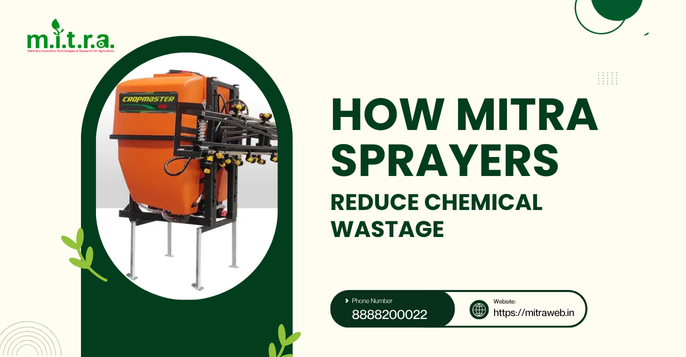Have you ever considered that a farmer might be wasting 30-50% of the chemicals they spray simply because the spray doesn’t reach all leaves, drifts away, or is applied with the wrong equipment? In India, where every rupee of input matters, chemical wastage is not just a loss, it’s an avoidable burden on the farm economy, human health, and the environment. In this post, we’ll explore the current challenges of chemical wastage in farming, how modern agriculture sprayer machines are helping solve them, and why choosing the right agriculture sprayer, especially a robust tractor-mounted sprayer, can make all the difference. We’ll also demonstrate how MITRA sprayers are driving this change, and how you can select, utilise, and benefit from them.

The Problem: Chemical Wastage in Modern Indian Agriculture
India uses millions of litres of pesticides, herbicides, and fertilisers each year. Much of that is lost due to inefficient application. According to recent studies, drift, non-uniform spray coverage, wrong droplet sizes, and over-application are major causes of chemical wastage. For example, precision agriculture trials have shown that using smarter spraying techniques can yield a 30-to-50% reduction in chemical costs while improving pest control effectiveness. (MIT News)
In horticultural crops such as mangoes, oranges, grapes, pomegranates etc., which have dense canopy or tall trees, spray droplets often fail to reach inner leaves, or chemicals are washed off, or blown away by wind. Manual pumping or knapsack sprayers, common among small farmers, suffer from lack of uniform pressure, inconsistent application, and fatigue which leads to over-spraying. All this contributes to more chemicals used, more cost, more environmental damage, and more health risks.
These issues have consequences: residues in fruit, pollution of soil and water, health hazards for farm labour, and rising input costs. For small farmers, chemical costs form a significant part of cultivation expense, so reducing waste is vital for both profit and sustainability.
Trends in Sprayer Technology & Precision Agriculture
To address these problems, the agriculture industry is moving rapidly toward precision-oriented sprayer technology. Some of the latest trends:
- Smart sprayer machines with sensor-based control or GPS-enabled guidance to ensure uniform spray only where needed. mitraweb.in
- Air-assisted and air-blast sprayers that force the spray into dense foliage, improving coverage in orchards and vineyards.
- Low volume / ultra-low volume spraying, which reduces chemical quantity by increasing efficiency.
- Improved nozzle design, droplet size optimization, drift control using fan and airflow adjustments.
- Tractor-mounted sprayer systems becoming more popular as farms mechanise, since they cover more land in less time, with better control. All this leads to being able to spray large blocks efficiently, and reduce chemical waste.
Globally, the agricultural sprayers market was valued at about USD 3.64 billion in 2024 and is expected to grow significantly over the next decade, driven by demand for efficiency, environmental safety, and mechanization. Straits Research
In India, these trends are very relevant, especially in horticulture, orchards, vineyards, and plantations where spraying inefficiency is very high if old or manual methods are used.

MITRA: Leading the Way in Reducing Chemical Wastage
MITRA Agro Equipment Pvt. Ltd. (often just MITRA) is an Indian manufacturer focusing on high-quality, efficient, and accessible agriculture sprayer machines specially designed for Indian conditions.
What MITRA Does
- MITRA manufactures a wide variety of sprayers: orchard sprayers, vineyard sprayers, boom sprayers, air-blast sprayers, mini tractor sprayer pumps, duster machines, and more.
- MITRA offers tractor-mounted sprayers, tractor-operated trailed sprayers, and tractor-operated reel sprayers, with various tank capacities
- They consider uniform coverage, durable design, safety, simpler operation, and offering farmers value for money. Their machines are built with features such as air assist/air blast, multiple nozzles, HDPE tanks and robust filtration.

Key Features That Help Reduce Waste
- Uniform Coverage: MITRA’s sprayers ensure uniform distribution over the canopy thanks to good nozzle design and adequate air flow. For example, their air-assisted sprayers push spray into inner parts of trees, reducing missed spots.
- Right Capacity and Matching Sprayer Type: By offering models of different sizes (e.g. 200 L, 400 L, 600 L, up to 2000 L etc.), MITRA helps farmers avoid over-applying or buying too large/too small machines. Using too large a sprayer on a small orchard wastes both chemicals and effort.
- Tractor-Mounted Sprayer Strength: Tractor-mounted sprayer models (both mounted and trailed) reduce labour, improve travel over field, allow better spray pressure and droplet control. They are more stable and consistent than manual or handheld sprayers. MITRA’s tractor-mounted boom sprayers are especially useful in open fields.
- Air Assist / Fan Mechanism: MITRA’s Airotec Turbo models (200L, 400L, 600L etc.) come with strong fan outputs which help in driving spray into the canopy, reducing drift, and ensuring that chemicals adhere where needed.
- Multiple Nozzles and Adjustable Parameters: More nozzles, correct pressure, good filtration so that chemicals are properly atomized not too fine (which drift) or too coarse (which drip or miss). MITRA gives options.
How to Choose & Use a Sprayer to Minimize Waste
Even the best equipment won’t help if used incorrectly. Here are some tips and best practices:
- Pick the right type of agriculture sprayer for your field type and crop. For tall orchards use orchard or air-blast sprayers; for vineyards use reel or specialised orchard sprayers; for open fields boom sprayers are efficient.
- Select appropriate capacity: A tractor-mounted sprayer with 600 L tank might be overkill for small plots; it might cause wastage if tank is half empty.
- Nozzle selection and pressure: Choose nozzles that produce droplet sizes suitable for your crop and canopy. Using too fine droplets can drift, too coarse may not cover well.
- Air-assisted / fan speed adjustments: For dense canopies, air assist is crucial. Matching air speed with fan size and nozzle arrangement helps spray reach inner leaves.
- Calibrate your sprayer regularly: Measure output, check uniformity, check for leaks or clogging. Make sure droplet size, pressure etc. are within recommended range.
- Spray in favourable weather: Avoid high wind, avoid spraying just before rain etc. Morning or evening when wind is low.
- Train operators: Ensure they know how to use controls, maintain equipment, clean nozzles etc.
Real-World Impact: Case Studies & Benefits
- As mentioned earlier, technological improvements in sprayer machines and precision spraying (sensor-based etc.) led to 30-50% savings in chemical costs in some commercial farms. (MIT News )
- Research in India shows that conventional sprayers tend to waste chemicals through drift and non-uniform coverage. Use of air-blast, sensor, and fan-assisted sprayer machines significantly reduces drift and improves deposition. (Nature+1)
With MITRA’s machines, which combine air assist, correct nozzle count, uniform coverage, and tractor-mounted stability, a farmer can expect reduced wastage, lower input cost, better yield and quality (due to better pest / disease control), and less environmental/health risk.
In addition, fewer re-applications (due to better coverage) save time, labour, fuel (in tractor-mounted sprayer case) and hassle.
Challenges & Best Practices
Of course, adopting efficient sprayer machines has its challenges:
- Initial cost: Tractor-mounted sprayers with air-assist and large capacity are more expensive than manual knapsack pumps.
- Awareness: Many farmers are still not aware of how much they lose in wastage and what features to look for.
- Training & maintenance: Nozzles clog, pumps wear, air outputs change; regular maintenance is essential.
Access to finance or subsidies: Some farmers need help with financing or government subsidy schemes to afford better sprayers.
How to overcome these:
- Use demo programmes: MITRA offers demos (“Book Demo”) so farmers can see real savings.
- Government schemes/subsidies: Check with state agriculture departments for machinery subsidy or grants.
- Training: Partner with extension services or private providers to train on calibration, correct settings, nozzles etc.
- Choose the right model: If you have smaller land under orchards, you don’t have to buy the largest unit; MITRA offers smaller capacity sprayers, reels, etc. Use based on your crop type & land scale.
Conclusion
Reducing chemical wastage isn’t just about cutting input costs—it’s about safeguarding your health, your soil, your yield, and your future. Using the right agriculture sprayer, especially well-designed agriculture sprayer machines like those from MITRA, and choosing a proper tractor-mounted sprayer where applicable, you can achieve far better spray efficiency, coverage, and savings.
MITRA stands out by offering machines suited to Indian terrain and farms: robust build, air assist, nozzles, good capacities, matched to crop types. If you’re a farmer looking to cut waste, improve yields, and farm more sustainably, MITRA’s range is well worth exploring.
Evaluate your current spraying setup, are you losing spray to drift, or over-application? Reach out to MITRA, test one of their machines via a demo, compare the chemical cost savings, and move toward sustainable farming with efficient, precise spraying.
